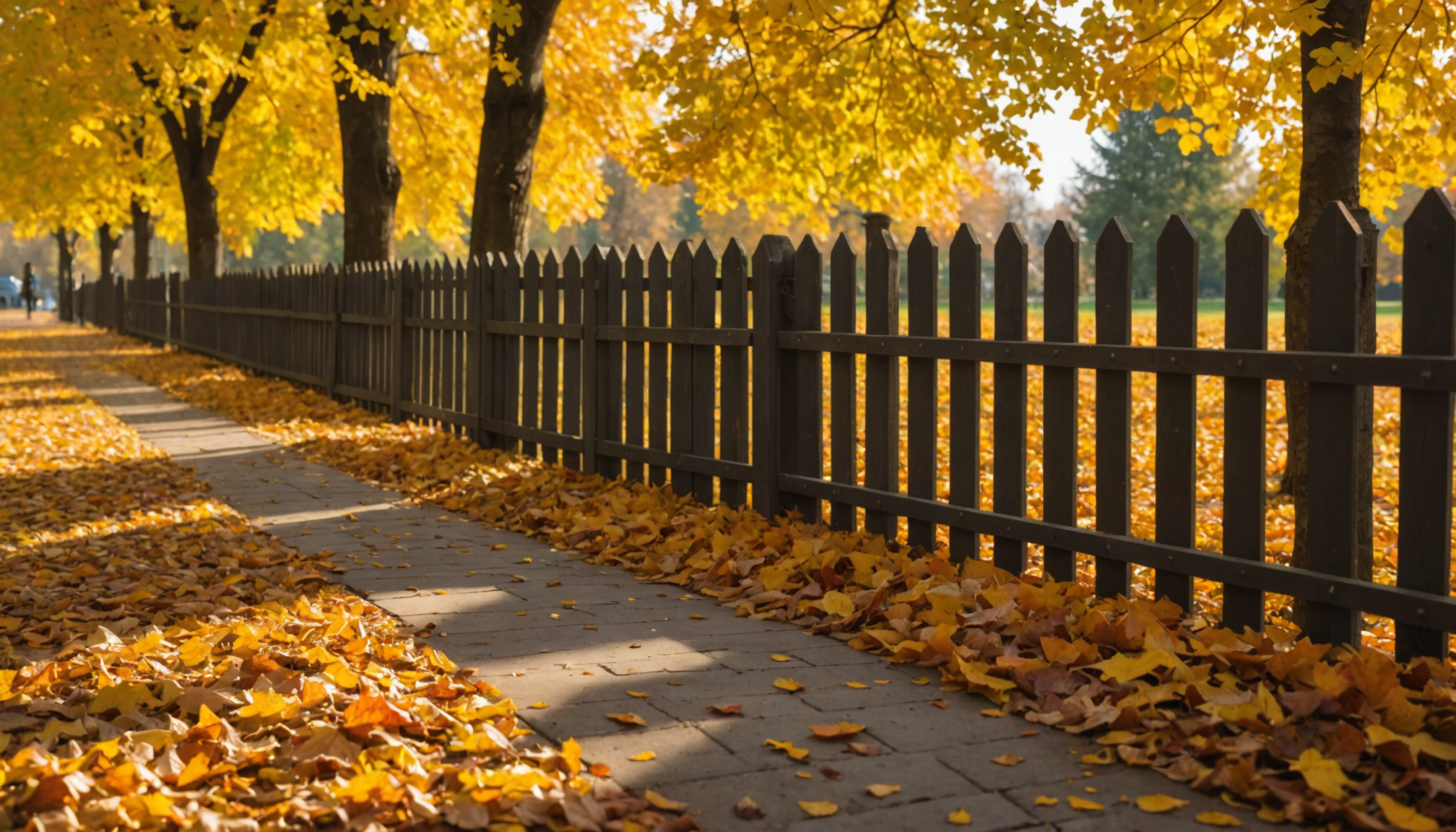Maintaining your fence year-round begins with regular inspections, as this proactive approach can prevent small issues from becoming significant problems. Seasonal inspections allow you to assess the condition of your fence and address any necessary repairs or maintenance tasks that align with the specific challenges each season presents. Here are a few detailed inspection tips tailored to different times of the year, ensuring your fence remains in optimal condition.
In the spring, focus on assessing any damage that might have occurred during the winter months. Begin by walking along the length of your fence to identify any signs of damage, such as broken boards, loose nails, or areas where the paint or sealant may have deteriorated. Pay special attention to the lower sections of the fence that may have been exposed to snow build-up or ice. Ensure that gate hardware is functioning properly, as the expansion and contraction caused by temperature changes can loosen screws or cause misalignment.
During the summer, with longer daylight hours and generally drier conditions, it’s an ideal time to check for any signs of dry rot or warping that could have developed unseen. Wood fences, in particular, are susceptible to these issues. Additionally, evaluate whether your fence is leaning or showing signs of instability which may be corrected by adjusting or reinforcing the fence posts.
Autumn provides a prime opportunity to prepare your fence for the harsher conditions of winter. Clear away falling leaves and other debris that may collect at the base of the fence, as this can create a damp environment conducive to rot. Inspect for rust or corrosion on any metal components, including hinges and nails, and address these before the onset of moisture-intensive winter months.
Here is a comparison of the typical seasonal inspection tasks:
| Season | Focus Areas | Tasks |
| Spring | Winter Damage Assessment | Inspect and repair broken boards, check paint or sealant status |
| Summer | Heat Effects | Look for dry rot and warping, ensure fence stability |
| Autumn | Winter Prep | Remove debris, inspect and treat metal parts |
Finally, winter can be a challenging time for outdoor structures. While active maintenance is typically limited, periodic checks on your fence’s condition during milder winter days can be beneficial. Look for disruptions caused by frost or heavy snowfall and ensure that panels are secure, especially following storms.
By adhering to a seasonal inspection routine, you not only extend the longevity of your fence but also enhance its appearance and effectiveness in providing security and aesthetic appeal to your property. Each season presents a unique set of challenges and opportunities to address issues before they escalate, making consistent inspections an essential part of fence maintenance.
cleaning and painting techniques
Regular cleaning and painting of your fence can both improve its appearance and extend its lifespan by protecting it from environmental elements. Following an effective cleaning and painting routine will keep your fence looking new and strong, so here’s a detailed guide to help you carry out these tasks efficiently.
- Gather Necessary Supplies: Before starting, collect all the materials you’ll need to clean and paint your fence. This includes a power washer or garden hose with a high-pressure nozzle, scrub brushes, mild detergent, sandpaper, paint, or stain, and suitable brushes, rollers, or a sprayer for painting.
- Prepare the Area: Begin by clearing the vicinity around the fence. Remove any overgrown plants or debris that might get in the way. Lay down a drop cloth to protect the surrounding areas from paint drips or over-spray.
- Cleaning the Fence:
- Rinse: Use a power washer or a hose with a high-pressure nozzle to rinse off loose dirt and debris thoroughly. Start at the top and work your way down to ensure an even clean.
- Scrubbing: Create a mixture of mild detergent and warm water. Use a scrub brush to apply this solution across the fence, focusing on areas with visible stains or mildew. For tough spots, allow the detergent to sit for a few minutes before scrubbing.
- Final Rinse: Once all the sections have been scrubbed, rinse the fence again with clean water to remove any remaining soap residue. Allow the fence to dry completely before proceeding to the next step.
- Sanding: Once the fence is dry, inspect the surface for rough patches or peeling paint. Use sandpaper to smooth out these areas, preparing the wood or material to better receive new paint or stain. Remember to remove the dust generated from sanding with a damp cloth.
- Choosing the Right Paint or Stain: Depending on the material and desired finish of your fence, select a suitable paint or stain. For wooden fences, an oil-based stain can enhance the natural look while offering robust protection. Alternatively, exterior paint specifically designed for fences can provide a solid color with additional defense against weathering.
- Painting/Staining the Fence:
- Apply Primer: For bare wood or a drastically new color, start with a coat of primer to ensure the paint adheres well and lasts longer.
- Paint or Stain: Using a brush, roller, or sprayer, apply the paint or stain in even strokes. Aim to work in manageable sections, allowing for smooth application without overlap marks.
- Second Coat: After the first coat has dried, assess whether a second coat is necessary for full coverage and durability. A second coat often deepens the color and adds more protection.
- Drying Time: Once painted or stained, allow the fence sufficient time to dry. This time can vary based on the product used and weather conditions. Check the manufacturer’s instructions for specific drying times.
- Final Touches: After the paint or stain has dried, inspect your work for any missed spots or uneven coverage. Touch up those areas as needed, and clean up the workspace, ensuring all tools and materials are stored properly.
Stick to a regular schedule for cleaning and repainting to ensure your fence remains a strong, attractive feature of your outdoor space. Through diligent care, you can prevent deterioration from weathering, mold, or other environmental factors, keeping your fence in excellent condition year-round.
repairing common damages
When it comes to keeping your fence in prime condition throughout the year, addressing common damages promptly is crucial. Timely repairs not only maintain the fence’s structural integrity but also prevent minor issues from escalating into costly problems. Here’s a concise guide to tackling typical fence damages effectively.
Start by examining the most frequent issues, such as broken or missing pickets, loose nails or screws, and unstable posts. Broken pickets should be replaced as soon as possible to prevent potential injury or security breaches. If a picket is damaged, remove it carefully using a pry bar or claw hammer, ensuring not to damage adjacent pieces. Once removed, measure and cut a new one to fit, then secure it with galvanized nails or screws to prevent rust.
For loose nails or screws, a simple tightening usually suffices. However, if they’re recurrently coming loose, consider replacing them with longer or more robust versions or opt for screws over nails, as they tend to secure more tightly and resist movement better over time.
When dealing with unstable posts, this could indicate deeper issues such as rotting or a poorly compacted base. First, inspect the base of the post for signs of rot, especially if it’s wooden. Rotting posts typically need replacement and ensuring they are treated with a weather-resistant sealant before installing them is a preventive measure. To replace a post, dig around the old one to remove it entirely and clear it of debris. Install the new post securely in a concrete footing to provide stability and prevent future wobbling.
Warps and cracks, particularly in wooden fences, are another common problem, often resulting from moisture and temperature fluctuations. Minor warps can sometimes be corrected by adjusting the installation brackets or hardware securing the boards. For cracks, use wood filler or exterior sealant to fill the splits, then sand and repaint the affected area to keep it sealed from the elements.
It’s important to address metal fence issues too, such as rusted sections or loose panels. Rust is best removed with a wire brush or sandpaper, followed by a rust-inhibiting primer before repainting. Tighten any loose panels or connections, and if the central framework appears corroded beyond repair, it might need section replacement or professional intervention.
Regularly tending to these repairs will extend the lifespan of your fence and enhance its functionality. Proactive management of damages ensures that minor issues remain small, avoiding the need for expensive overhauls in the future. Maintaining your fence meticulously also keeps it aesthetically pleasing and ready to withstand whatever nature throws at it next.
protecting against weather elements
To ensure your fence stands strong in the face of harsh weather conditions, implementing a robust protection strategy against weather elements is essential. Different weather patterns pose various threats to your fence, and taking preemptive measures can significantly enhance its durability and aesthetics.
Firstly, consider applying a high-quality water-repellent sealant or stain, especially on wooden fences, to safeguard them from moisture intrusion and UV rays. This protective coating creates a barrier that prevents rainwater from penetrating the wood, reducing the risk of rot, warping, and cracking. Ideally, seal or stain your fence every 2-3 years or more frequently if your area experiences extreme weather conditions, as these can expedite wear and tear.
Metal fences require attention too. For iron and steel fences, applying a rust-inhibiting primer followed by a weather-resistant paint or spray is crucial to prevent rust formation. This process not only protects the metal surface but also enhances its appearance. Regularly inspect your metal fence and reapply coatings at the first sign of wear.
Given that rain, snow, and ice can accumulate at the base of your fence, it’s crucial to maintain a properly graded landscape around it to ensure adequate water drainage. Standing water is a leading cause of base rot and weakening in fence posts. Installing gravel or cement bases for posts can further mitigate this issue, as they provide a stable foundation less prone to water damage.
The winter season presents particular challenges, such as heavy snowfall and ice buildup, which add undue pressure on your fence. To alleviate weight and prevent sagging or breakage, promptly clear snow off and around your fence. An ice melt product suitable for the specific fence material can be used cautiously to address ice without causing corrosion or other damage.
Windstorms are another potential threat that can topple or damage fences. Reinforcing your fence’s structural elements, such as posts and panels, can prevent such outcomes. Check existing post anchors and replace them with sturdier alternatives if necessary. In areas prone to high winds, consider wind-resistant designs or additional bracing techniques that provide enhanced stability.
Finally, don’t overlook shrubbery and plants growing near your fence, as they can retain moisture and contribute to deterioration. Regularly prune back vegetation to promote air circulation, which helps keep your fence dry and free from mold and mildew growth.
By implementing these measures, you can not only extend the life of your fence but also maintain its aesthetic appeal year-round. Remember, being proactive in protecting your fence from the elements ensures it remains a strong, durable, and attractive feature of your property.
pest and rot prevention strategy
To effectively shield your fence from pests and rot, a well-structured prevention strategy is essential. Various organisms and environmental conditions can attack your fence, particularly wood-based ones, weakening its structure and appearance over time. By proactively addressing these threats, you can significantly mitigate their impact and prolong your fence’s life.
Start by selecting pressure-treated or naturally resistant wood species, such as cedar or redwood, when constructing or replacing parts of your wooden fence. These types possess natural resistance to pests like termites and fungi, reducing the likelihood of infestation or decay. If your fence is not already made from such materials, consider applying a wood preservative or insecticide specifically formulated to repel pests and prevent rot. This treatment should be renewed every couple of years to maintain its efficacy, especially in climates prone to high humidity or frequent rain.
Regularly inspect your fence for any signs of pest activity or rot, such as small holes, wood dust, or spongy areas. Early detection is key to controlling pests before they cause significant damage. When setting up new plants near your fence, maintain a gap to ensure proper airflow and prevent moisture build-up, which can encourage rot. It’s also crucial to clear organic debris, like fallen leaves, from around the base of the fence, as this can trap moisture and provide breeding grounds for termites and mold.
Another effective approach involves setting up a physical barrier to block pest access. Install galvanized mesh or other suitable deterrents along the base of your fence to keep burrowing insects out. If you have metal fences, prevent rust—a common precursor to structural weakening—by regularly applying rust-resistant coatings and promptly addressing any moisture damage.
Ensure proper drainage around your fence, especially wooden ones, to avoid pooling water—a major risk factor for both rot and pest infestation. Installing gravel beds or adjusting the grade of the landscape can facilitate better water runoff, keeping the fence base dry. In addition, avoid having soil or mulch in direct contact with your wood fence as it can foster a moist environment conducive to pest activity and rot.
By adopting these practices, you safeguard your fence against threats that can compromise its integrity and appeal. Regular maintenance, combined with strategic preventive measures, ensures your fence remains a sturdy and attractive element of your property—a buffer to protect not just your home’s perimeter, but its overall aesthetic quality.
In conclusion, maintaining your fence year-round involves a commitment to regular inspections, timely repairs, and strategic preventive measures. By diligently applying cleaning, painting, and protection techniques tailored to the unique demands of each season and potential threats like pests and weather, you ensure your fence remains robust, visually appealing, and long-lasting. With consistent care, your fence will not only enhance the beauty and security of your property but also withstand the test of time.


